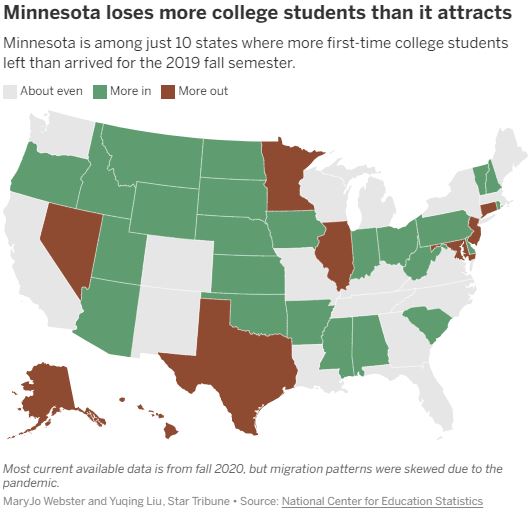Progressives begin to face the facts of Minnesota’s population loss
When I have pointed out the record numbers of Minnesotans fleeing the state in recent years, one of the standard responses has been:
…something like “breaking news: old people are leaving frozen bad weather state for warm weather” or “We’re surprised that baby boomers are retiring to warm states?”
In fact, there is data available from the Internal Revenue Service on the ages of these domestic migrants and it refutes the argument that the exodus of Minnesotans to other states is driven solely by retirees or “Boomers.”
…contrary to the retirees and “Boomers” argument, our state sees this net loss of residents to other states across five of the six categories the IRS data breaks it down into, including those under 26.
These facts are now being more widely acknowledged. In a recent article titled ‘Are Minnesotans really fleeing to low-tax states?’ the Minnesota Reformer noted:
State demographer Susan Brower points to another, often overlooked factor as a key driver of Minnesota migration: college decisions.
“Most migrants are in their late teens and 20s,” Brower said via email. “I think it shows the large share of migration that’s driven by college choices.”
Census data analyzed by Brower’s office shows that the migration gap among those age 15 to 19 is particularly steep, with thousands more people in that cohort moving away from Minnesota between 2015 and 2019.
And, last week, the Star Tribune reported:
Every year, thousands more college students leave Minnesota than arrive, a Star Tribune analysis of U.S. census data shows. Boosters and business leaders warn that the losses could have major consequences for the state’s workforce in the not-so-distant future.
…
While Minnesota’s higher education institutions do pull many young people from other states, the state overall loses roughly 8,000 more 18-to 24-year-olds each year than it gains, the Star Tribune’s census analysis found. And often they don’t come back.
“It really adds up over time,” said Sean O’Neil, the Minnesota Chamber of Commerce’s director of economic development and research.
College students make up nearly two-thirds of the state’s annual net loss in domestic migration. Drawing people from across the U.S. and internationally is increasingly essential to maintain the state’s population and economy as the birth rate declines. Within 20 years, Minnesota is expected to have more residents die each year than are born.
Minnesota saw a net loss of about 156,000 young adults to other states between 2006 and 2021, O’Neil said.
“As we think about ways to stabilize and grow our workforce, that really has to be part of the solution and part of the equation,” O’Neil said. “It just is where the numbers are.”
…
The state exports nearly twice as many first-time college students as it brings in. Only seven states had a worse ratio of students moving out than moving in, according to an analysis of 2019 federal education data.
And all this, of course, at a time when Minnesota’s colleges cannot fill the slots they have available.
The Strib does see:
…a silver lining for the post-college age range. About 3,000 more people between 25 to 39 move to Minnesota each year than depart, census figures show. Roughly 40% of those moving here in that age range were either born here or are married to someone who was. That’s the ninth-highest rate in the nation.
But it is forced to note glumly that:
The population gain in that bracket does not make up for the loss of younger adults, many of whom find jobs, partners or interests that permanently shift their trajectory away from Minnesota.
Where are they going?
The Strib reports that:
They are largely going to neighboring states. North Dakota State University took in the most Minnesotans, followed by the University of Wisconsin-Madison, then the University of Wisconsin-Eau Claire, state data shows.
Indeed, while Minnesota attracts 6.7 college students for every 10 who leave, Wisconsin attracts 13.3, South Dakota 19.6, North Dakota 26.9, and Iowa 35.5.

Why are they going?
The Strib doesn’t dig too deeply into why Minnesota’s college-age residents are fleeing the state. The most in-depth discussion is:
“Migration is being driven by decisions that happen very early on in adult life,” Brower said. “Think of the late teens in your life, early 20s. They are moving for college, they are moving because they are in love and they are following someone across the country, they’re deciding to go skiing in Colorado.”
But this just begs more questions. Why are colleges in other states more attractive? Why are Minnesotans following people they love to other states and not bringing them here? Why are outdoor amenities more attractive in other states?
One student is quoted as saying “It makes me feel like, at least when I’m young, there are more opportunities in the bigger cities than back home.” And this begs another question: why are opportunities “bigger” in other states than in Minnesota?
It is welcome, if overdue, that the state’s media is finally facing up to the statistical reality we have long pointed out. Now we must address the questions it raises.